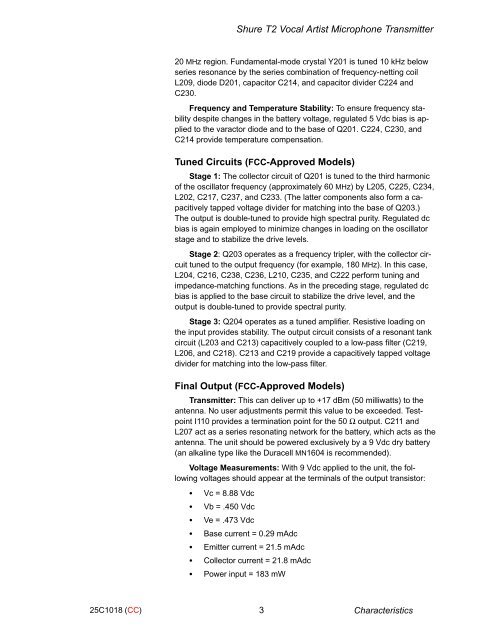SERVICE MANUAL CHANGE NOTICE
shure
shure
Create successful ePaper yourself
Turn your PDF publications into a flip-book with our unique Google optimized e-Paper software.
Shure T2 Vocal Artist Microphone Transmitter<br />
20 MHz region. Fundamental-mode crystal Y201 is tuned 10 kHz below<br />
series resonance by the series combination of frequency-netting coil<br />
L209, diode D201, capacitor C214, and capacitor divider C224 and<br />
C230.<br />
Frequency and Temperature Stability: To ensure frequency stability<br />
despite changes in the battery voltage, regulated 5 Vdc bias is applied<br />
to the varactor diode and to the base of Q201. C224, C230, and<br />
C214 provide temperature compensation.<br />
Tuned Circuits (FCC-Approved Models)<br />
Stage 1: The collector circuit of Q201 is tuned to the third harmonic<br />
of the oscillator frequency (approximately 60 MHz) by L205, C225, C234,<br />
L202, C217, C237, and C233. (The latter components also form a capacitively<br />
tapped voltage divider for matching into the base of Q203.)<br />
The output is double-tuned to provide high spectral purity. Regulated dc<br />
bias is again employed to minimize changes in loading on the oscillator<br />
stage and to stabilize the drive levels.<br />
Stage 2: Q203 operates as a frequency tripler, with the collector circuit<br />
tuned to the output frequency (for example, 180 MHz). In this case,<br />
L204, C216, C238, C236, L210, C235, and C222 perform tuning and<br />
impedance-matching functions. As in the preceding stage, regulated dc<br />
bias is applied to the base circuit to stabilize the drive level, and the<br />
output is double-tuned to provide spectral purity.<br />
Stage 3: Q204 operates as a tuned amplifier. Resistive loading on<br />
the input provides stability. The output circuit consists of a resonant tank<br />
circuit (L203 and C213) capacitively coupled to a low-pass filter (C219,<br />
L206, and C218). C213 and C219 provide a capacitively tapped voltage<br />
divider for matching into the low-pass filter.<br />
Final Output (FCC-Approved Models)<br />
Transmitter: This can deliver up to +17 dBm (50 milliwatts) to the<br />
antenna. No user adjustments permit this value to be exceeded. Testpoint<br />
I110 provides a termination point for the 50 Ω output. C211 and<br />
L207 act as a series resonating network for the battery, which acts as the<br />
antenna. The unit should be powered exclusively by a 9 Vdc dry battery<br />
(an alkaline type like the Duracell MN1604 is recommended).<br />
Voltage Measurements: With 9 Vdc applied to the unit, the following<br />
voltages should appear at the terminals of the output transistor:<br />
<br />
<br />
<br />
<br />
<br />
<br />
<br />
Vc = 8.88 Vdc<br />
Vb = .450 Vdc<br />
Ve = .473 Vdc<br />
Base current = 0.29 mAdc<br />
Emitter current = 21.5 mAdc<br />
Collector current = 21.8 mAdc<br />
Power input = 183 mW<br />
25C1018 (CC)<br />
3 Characteristics



